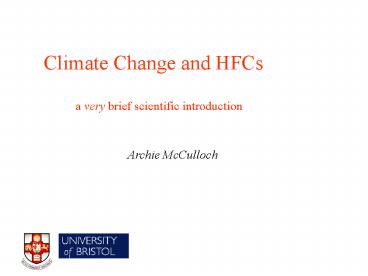Climate Change and HFCs - PowerPoint PPT Presentation
1 / 21
Title:
Climate Change and HFCs
Description:
CFC - chlorofluorocarbon. HCFC - hydrochlorofluorocarbon. CFCs and HCFCs. Deplete stratospheric ... Carbon dioxide (CO2), methane, nitrous oxide, perfluorocarbons ... – PowerPoint PPT presentation
Number of Views:167
Avg rating:3.0/5.0
Title: Climate Change and HFCs
1
Climate Change and HFCs
a very brief scientific introduction
Archie McCulloch
2
Greenhouse Gases (Kyoto)
Carbon dioxide - CO2 Methane - CH4 Nitrous oxide
- N2O The F-gases HFC - hydrofluorocarbon PFC
- perfluorocarbon SF6 - sulphur hexafluoride
3
Greenhouse Gases (Kyoto)
Carbon dioxide - CO2 Methane - CH4 Nitrous oxide
- N2O The F-gases HFC - hydrofluorocarbon PFC
- perfluorocarbon SF6 - sulphur hexafluoride
Montreal Protocol Gases
CFC - chlorofluorocarbon HCFC -
hydrochlorofluorocarbon
4
CFCs and HCFCs Deplete stratospheric ozone Are
also Greenhouse Gases
5
CFCs and HCFCs Deplete stratospheric ozone Are
Greenhouse Gases
stratosphere
40 km
25 km
15 km
6
CFCs and HCFCs Deplete stratospheric ozone Are
Greenhouse Gases Production and Consumption are
controlled by the Montreal Protocol. Emissions
are not controlled. Stratospheric Ozone
Depletion and Climate Change can be addressed
separately, even though they have
scientific interconnections.
stratosphere
40 km
25 km
15 km
7
HFCs Do not deplete stratospheric ozone Are
Greenhouse Gases
40 km
25 km
troposphere
15 km
8
HFCs Do not deplete stratospheric ozone Are
Greenhouse Gases Emissions are controlled under
the Kyoto Protocol. Other Kyoto Greenhouse Gases
are Carbon dioxide (CO2), methane, nitrous
oxide, perfluorocarbons sulphur hexafluoride
(SF6) - all controlled Ozone, hydrocarbons - not
controlled.
40 km
25 km
troposphere
15 km
9
The Environmental Impact of any substance
depends on The Quantity of the Substance
EMITTED and The Properties of the Substance
10
These Window air conditioners will affect climate
change by EMISSION of greenhouse gases.
11
They consume electricity, which is generated from
fossil fuel combustion and so results in EMISSION
of CO2
12
They consume electricity, which is generated from
fossil fuel combustion and so results in EMISSION
of CO2 During normal operation there is NO
EMISSION of the operating fluid.
13
They consume electricity, which is generated from
fossil fuel combustion and so results in EMISSION
of CO2 During normal operation there is NO
EMISSION of the operating fluid. When the units
are serviced or scrapped the fluid may be
emitted.
14
Their Environmental Impact depends on The
quantity of electricity used (which has
implications for energy efficiency) and The
amount of operating fluid emitted, and its Global
Warming Potential (GWP).
15
Greenhouse gases
absorb infra-red radiation and hence can affect
the climate for as long as they persist in the
atmosphere.
CO2
16
Greenhouse gases
absorb infra-red radiation and hence can affect
the climate for as long as they persist in the
atmosphere.
Global Warming Potential (GWP)
is a measure over a fixed time period of the
effect of an emission of ONE kilogram of the
greenhouse gas compared to the effect from ONE
kilogram of carbon dioxide over the same
period. It takes account of the absorption
effectiveness of the gas and its persistence. The
persistence of CO2 is ignored.
17
Global Warming Potentials (up to 100 years)
1 21 310 140 1300 2800 11700 6500 23900
CO2 Methane Nitrous Oxide HFC-152a HFC-134a HFC-
125 Fluoroform PFC-14 SF6
On their own, these numbers do not describe the
impact of the gases.
18
Global Warming Potentials (up to 100 years)
Emission during 2000 (tonnes)
1 21 310 140 1300 2800 11700 6500 23900
30,800,000,000 350,000,000 11,000,000 100,000
7,000 15,000 6,000
CO2 Methane Nitrous Oxide HFC-152a HFC-134a HFC-
125 Fluoroform PFC-14 SF6
19
Carbon Dioxide
Methane
SF6
ODS are Ozone Depleting Substances controlled
under the Montreal Protocol
Nitrous oxide
PFCs
ODS
HFCs
20
Actual Production
21
With thanks to AFEAS (Alternative
Fluorocarbons Environmental Acceptability
Study) for emission and production
data IPCC (Intergovernmental Panel on
Climate Change) for Global Warming
Potentials and Greenhouse Gas emission
data University of East Anglia for the Climate
Model































